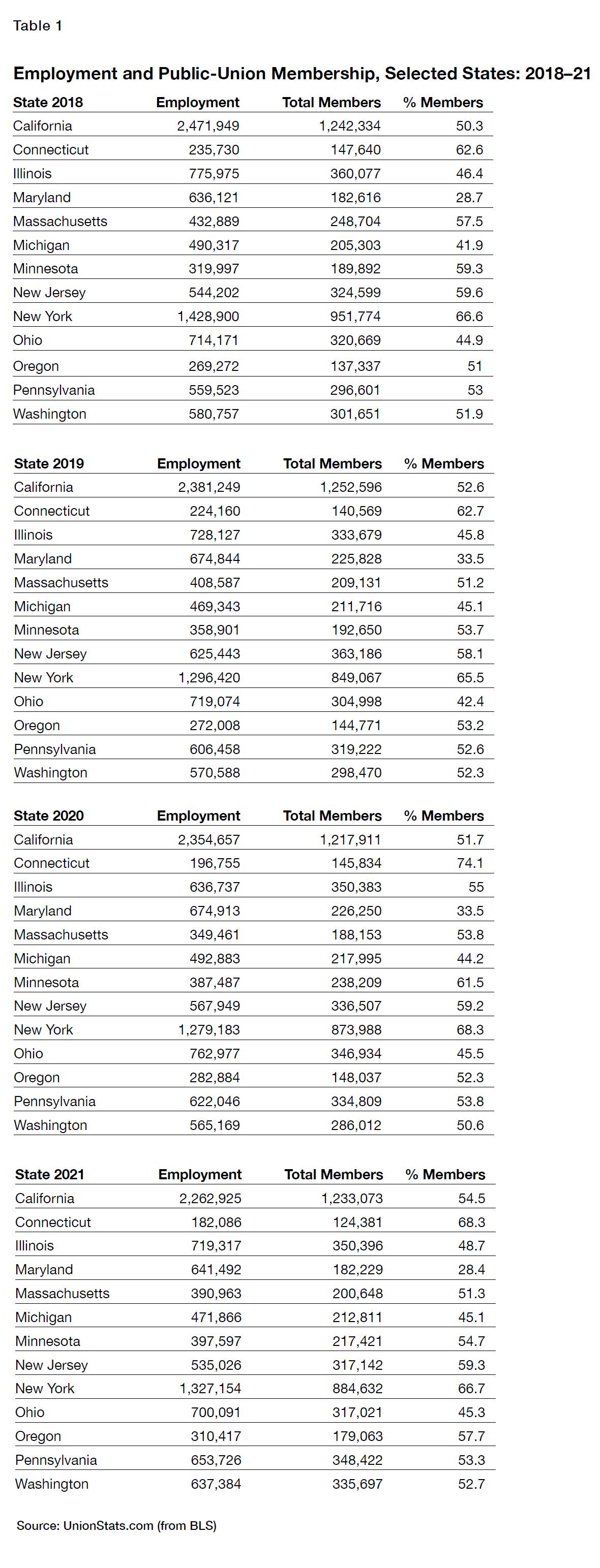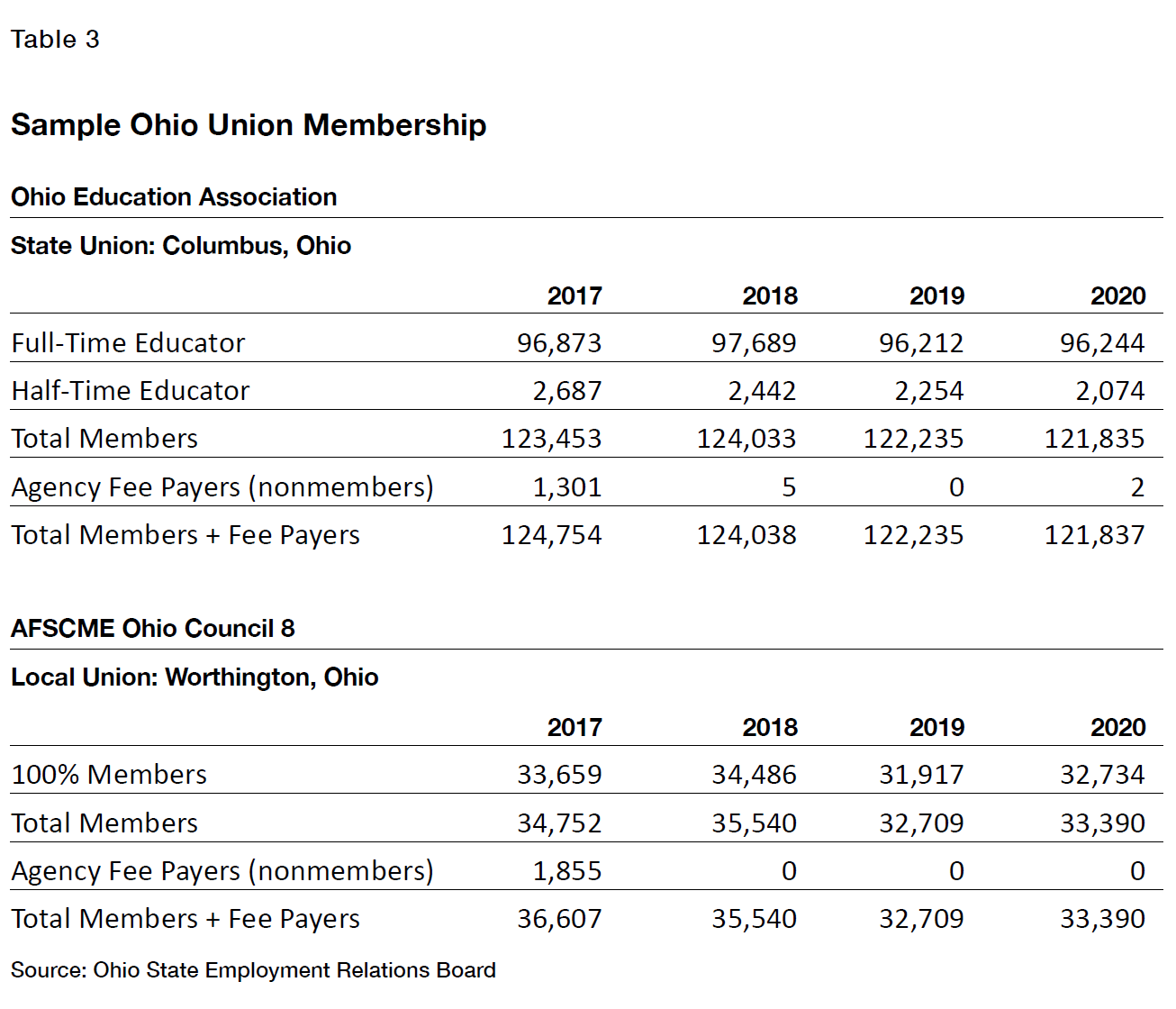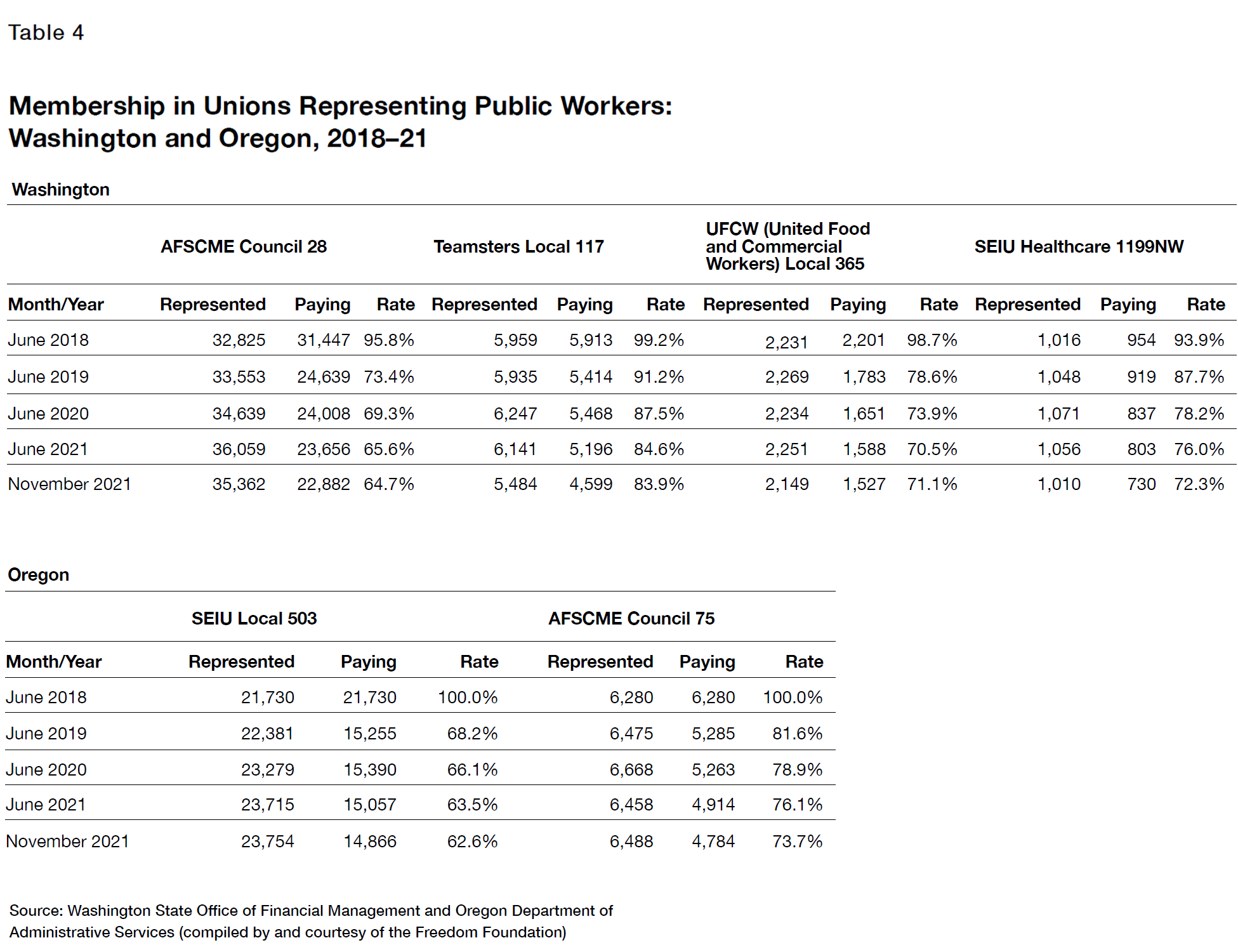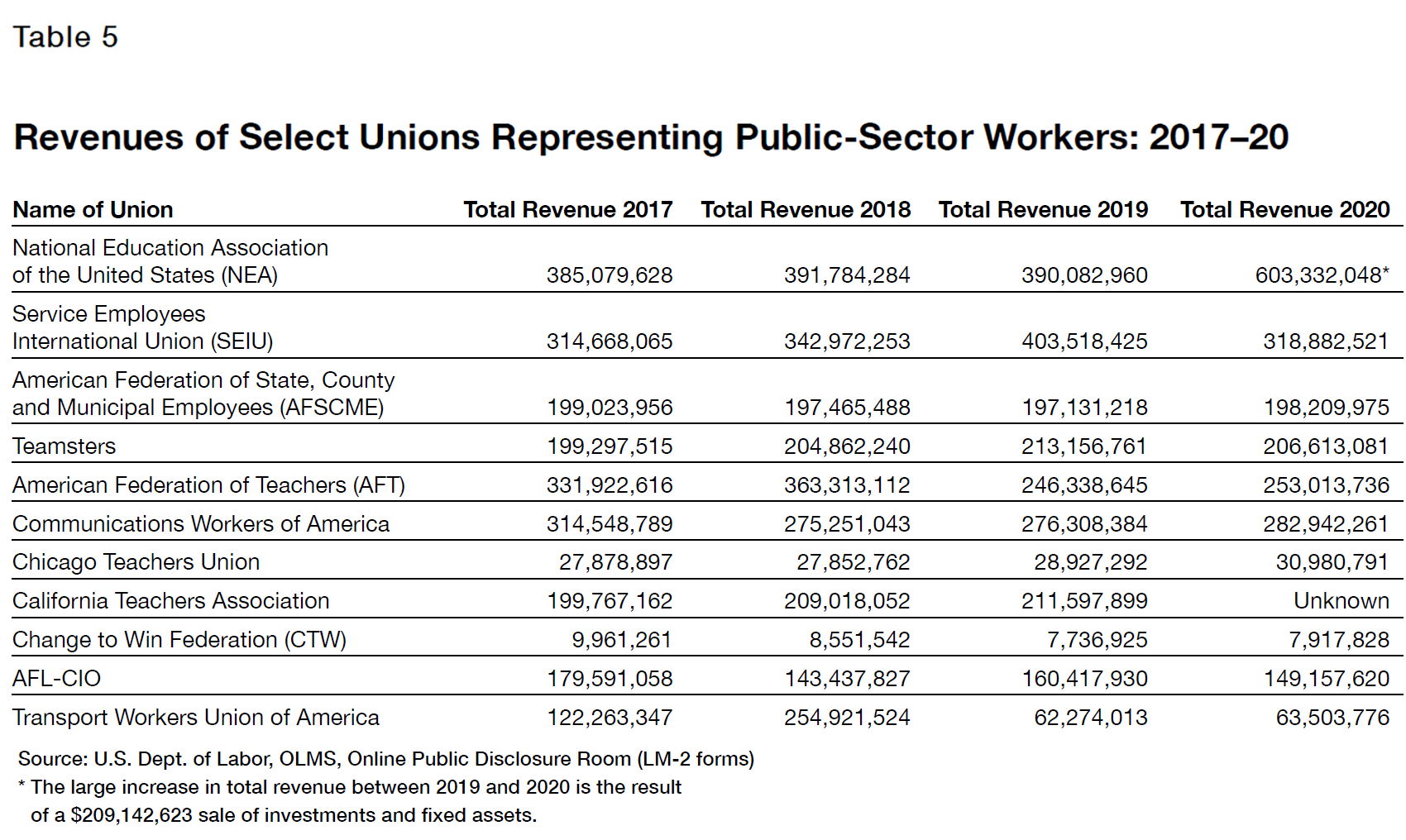By the Numbers: Public Unions' Money and Members Since Janus v. AFSCME

Many observers predicted that the Supreme Court’s 2018 decision in Janus v. AFSCME—which ruled that nonunion government employees could not be compelled to pay “agency fees” to unions—would severely erode public-sector union membership and, with it, union revenues. By examining all the major public data sources on union membership and revenue through 2021, this report shows that, for the most part, such predictions were wrong, and it explains the reasons.
- The percentage of public employees belonging to unions has remained largely flat since the Janus decision.
- Much of the decline in the number of public-sector union members could be due to declines in public-sector employment.
- Employer records from Washington State and Oregon show larger declines in union membership than elsewhere. Because this data source is the most accurate available, it suggests that other data sources, which rely on reporting by unions themselves or individual workers, may overestimate union membership.
- After initial losses of agency fee revenues, public unions have been able to stabilize their finances—in some cases, by raising dues. Nevertheless, unions will eventually be unable to raise dues any higher without causing membership attrition—and, as a result, public-union federations will be less able to generously subsidize unions in weak union states using monies from revenue in strong union states.
Ultimately, only when the federal government requires better reporting by public-sector unions will workers, government employers, and the taxpaying public be able to accurately judge the character of unions that negotiate with governments to set important public policies.
Introduction
In June 2018, the U.S. Supreme Court handed down a controversial 5–4 decision in Janus v. American Federation of State, County, and Municipal Employees, Council 31.[1] The court ruled that the laws of 22 states (covering 5.9 million public workers) that obliged government employees who were not union members to pay “agency fees” to unions violated their First Amendment rights by “compelling them to subsidize private speech on matters of substantial public concern.” Agency fees are supposed to be a percentage of members’ union dues, which unions are supposed to use for collective bargaining activities but not for other purposes, such as lobbying for legislation or supporting candidates for political office. Since Janus, no state or local government employee can be forced, as a condition of employment, to pay anything to a union unless he or she “affirmatively consents” to do so.
Many observers predicted that the decision would put public-sector unions on a road to extinction by depriving them of money and members.[2] Such an outcome was forecast by Justice Elena Kagan in her Janus dissent. The majority’s decision, Kagan wrote, would unleash “large-scale consequences” that could “alter public-sector labor relations.” Disruption of those relations might disturb “government services,” she argued, “that affect the quality of life of tens of millions of Americans.”
The logic of such predictions was straightforward. If nonmember workers no longer had to pay for union representation, members of the union could opt out and get representation for free; the result would be less union revenue and fewer workers belonging to unions. Union strength at the bargaining table and in the political arena would decline, while the power of government managers would increase. Those on the left deplored this prospect, while those on the right cheered it.[3] Neither has so far proved correct.
Although unions have lost agency fee revenues and some unions have lost members, the Janus decision has so far had a limited impact on public-union membership and money and has not led to large-scale consequences. Public-sector unions continue to lobby, finance candidates, and, where legal, represent all workers in collective bargaining. The only disruptions of public services that the country has experienced since Janus have been the traditional ones, such as strikes and other work stoppages, caused by unions themselves.[4]
For instance, in 2018 and 2019, public school teachers—many in weaker union states and cities—engaged in strikes and work stoppages in record numbers. Large-scale teacher walkouts occurred in Oklahoma, Kentucky, Arizona, and West Virginia.[5] Strikes also occurred in Los Angeles and Denver, as well as in a number of smaller school districts around the country. During the Covid-19 pandemic, which began in March 2020, teachers' unions have shaped the mode of instruction and a host of K–12 public school policies.[6] Districts with strong unions have had less in-person instruction, affecting children in minority communities in urban centers especially hard.[7] Most recently, in January 2022, the Chicago Teachers Union forced the mayor and the school district to delay the start of the spring semester for nearly two weeks, sparking widespread concern among Chicago parents and rare criticism from Mayor Lori Lightfoot.
In the wake of George Floyd’s death at the hands of the Minneapolis police in summer 2020, unions representing police officers have come under increased scrutiny. Many charge them with winning too many job protections that keep bad cops on the beat.[8]
As these examples attest, public-sector unions remain powerful actors in American politics, especially at the state and local levels. This report documents the impact of the Janus decision on union members and money and shows why they have been more stable than many observers predicted.
Pre-Janus
Before examining what has happened since Janus, one must begin with the status quo ante. Since at least the Supreme Court’s 1977 decision in Abood v. Detroit Board of Education, public-sector unions in many states had a powerful tool for increasing membership and revenue. Under the terms of Abood and other Supreme Court decisions, public workers could not be forced to join unions as a condition of employment—but they could be forced to pay fees to the unions for representing them in collective bargaining. Unions often set the cost of such agency fees as identical to the cost of dues (forcing the worker to take a series of steps to opt out of those monies spent on politics). Because employees had to pay the union representing them whether they joined or not, there existed a strong incentive for most workers to join. Only a small percentage of workers with ideological objections tended to hold out.
Since Abood, the effect of enshrining agency fees in state legislation or collective contracts was to artificially increase union membership and dues revenues. Government policy, in short, put its thumb on the scale in favor of higher public-union membership. Membership plateaued over time at roughly 35% of the public-sector workforce nationally, with about 42% of local government employees being the most heavily unionized.[9]
Mark Janus was an Illinois state employee whose unit was represented by AFSCME (American Federation of State, County and Municipal Employees). He declined to join the union because of his opposition to many of its positions and sued to prevent the union from collecting agency fees from his paycheck. When his petition arrived before the Supreme Court, public unions were at a high point, even though they’d suffered some recent setbacks in Indiana, Wisconsin, and a few other places in recent years.[10] Thanks to the laws of 22 states—which included some of the most populous states in the country and a majority of all public employees—these unions had built up strong organizations.[11] Their membership was large and stable. Over 90% of teachers belonged to unions in California, for example, and that percentage had been steady for decades.
However, the Janus decision would not mean that the unions had to dramatically increase their membership to retain their power. Instead, they would need only to hold on to as many of their existing members as possible, get even a small slice of current nonmembers to finally join, and do a good job in recruiting new hires—all of which could offset any attrition from existing members who might decide to opt out. In fact, public unions before and immediately after the Janus case launched major organizing drives to bring existing nonunion workers into the fold. AFSCME, SEIU (Service Employees International Union), NEA (National Education Association), AFT (American Federation of Teachers), and other public-employee unions mounted a campaign that included updating their membership records, polling public workers, and enlisting them to sign “enhanced” union membership cards.[12]
Post-Janus
Government unions also stepped up their lobbying and political activity, which sparked an immediate legislative response from over a third of the states affected by the Court’s decision (some even acted before the decision). Over a third of these states adopted measures to soften the blow of the loss of agency fees. These states, including New York, California, Maryland, and Washington, provided unions with existing employees’ contact information, for example, and required new hires to meet with union representatives during worktime so that the unions could press their case for membership.[13] Some of the new state laws allowed government-employee unions to offer services—such as life insurance, vision and dental coverage, and legal representation in grievance and arbitration proceedings—exclusively to members, making membership more attractive. Finally, many of the new state laws made it harder for union members to revoke their membership.
In sum, these laws were designed to give public-sector unions more tools to retain existing members and recruit new ones. They also serve as contingency measures for public unions to survive the Janus ruling unscathed or as financially unaffected as possible.
Virginia even passed a law in 2021 that permitted—for the first time in the state’s history—local governments to engage in collective bargaining. To be sure, it remains to be seen how successful unions will be in recruiting members without agency fees, as the task they face is much harder than holding on to existing members and recruiting new hires. In the Old Dominion, the unions must build up organizations and recruit new members from existing employees who have never been union members. That is a heavier lift.
In sum, the existing organizational environment prior to the Janus decision and the new laws passed since have worked to prevent attrition from public-sector unions. The result is that union membership and revenue have not fallen as much as originally predicted.
Membership
There are four ways to estimate and measure the number of public-sector union members. One is survey data gathered by the U.S. Department of Labor’s Bureau of Labor Statistics (BLS). Another is union financial reports filed annually with the department’s Office of Labor-Management Standards (OLMS). A third source is the state of Ohio, which requires public- and private-sector unions to file reports similar to those filed with OLMS. The fourth is through government employers’ payroll data. For the purposes of tracking changes since the Janus decision, each has its advantages and disadvantages.
BLS data are based on the results of the Community Population Survey (CPS), which is conducted by the U.S. Census Bureau and BLS and released annually. It offers estimates of national union membership in the public and private sectors. However, it provides only a total union membership estimate for each state, undifferentiated by the public and private sectors. In addition, many respondents don’t know or are unsure about their union membership status, which can bias the results.
From 2018 to 2021 (the most recent year for which data are available), BLS data show a tiny increase in the percentage of public-sector union membership nationally. After inching up in 2020 to 34.8%, membership in public-sector unions remained flat from 2020 to 2021, at 33.9% nationally. At the local level, there was a slight decline from 2020 to 2021—from 41.7% to 40.2%. Nonetheless, both figures are consistent with a stable longer-term trend. Since the late 1970s, 32%–37% of the public-sector workforce (and slightly more than 40% of the local government workforce) have been union members. In short, the picture from BLS data shows virtually no change in the percentage of public workers belonging to unions.
That is not the end of the story, however. Economists at Georgia State University break down BLS data for their website, UnionStats.com, by state and sector. While very helpful, these estimates should be treated with some skepticism. The reason is that once CPS survey data are disaggregated, the sample sizes are small. As a result, UnionStats sometimes reports large swings in membership and other responses in some states when there is little other evidence that such changes occurred.
All that said, UnionStats data suggest that, from 2018 to 2021, strong union states affected by Janus experienced slight increases in union membership, while others experienced slight declines. But the devil is, as always, in the details. Public-union membership in California went from 50.3% in 2018 to 54.5% in 2021. But that higher percentage masks a reported fall in total members because the size of the California public workforce dropped by nearly 200,000 employees, according to BLS data. Public-union membership in New York, on the other hand, saw a tiny increase in this period, from 66.6% to 66.7%, while the size of the public workforce apparently dropped by about 100,000 workers. Therefore, the Empire State had 951,774 public-union members in 2018 but only 884,632 in 2021. Similarly, the percentage of public-sector workers who were members of a union in Ohio experienced a small increase, as public employment declined by a small amount (Table 1).
Two overall conclusions can be drawn from the UnionStats data. One is that union membership was relatively stable in most of the states affected by Janus. The other is that the lion’s share of any given decline in the number of union members likely came from a reduction in the size of the state’s public workforce.
OLMS data are available because of the 1967 Labor-Management Reporting and Disclosure Act (LMRDA), which requires any union, even with just one member working in the private sector, to file a detailed annual financial disclosure report (an LM-2, which includes membership numbers) with the U.S. Department of Labor.[14]
The downside of OLMS data is that many public-sector unions are exempt because they do not represent any private-sector employees, and LM-2s make it difficult to sort out which are public and which are private employees. However, an upside is that some of the bigger unions, such as NEA and AFSCME, are subject to LMRDA’s provisions. LM-2 reports can provide helpful insight into the membership size and financial practices of these large-scale unions. Therefore, a partial picture of membership trends can be estimated for some large public unions.[15]
The picture that emerges is one of overall stability with small declines or slight increases in the number of union members. AFSCME, for example, reported a tiny gain of about 4,000 members between 2018 and 2020 (increasing from 1,023,603 to 1,027,437). NEA, however lost some 24,000 active professional members (declining from 2,124,054 to 2,100,007) over the same period (Table 2).
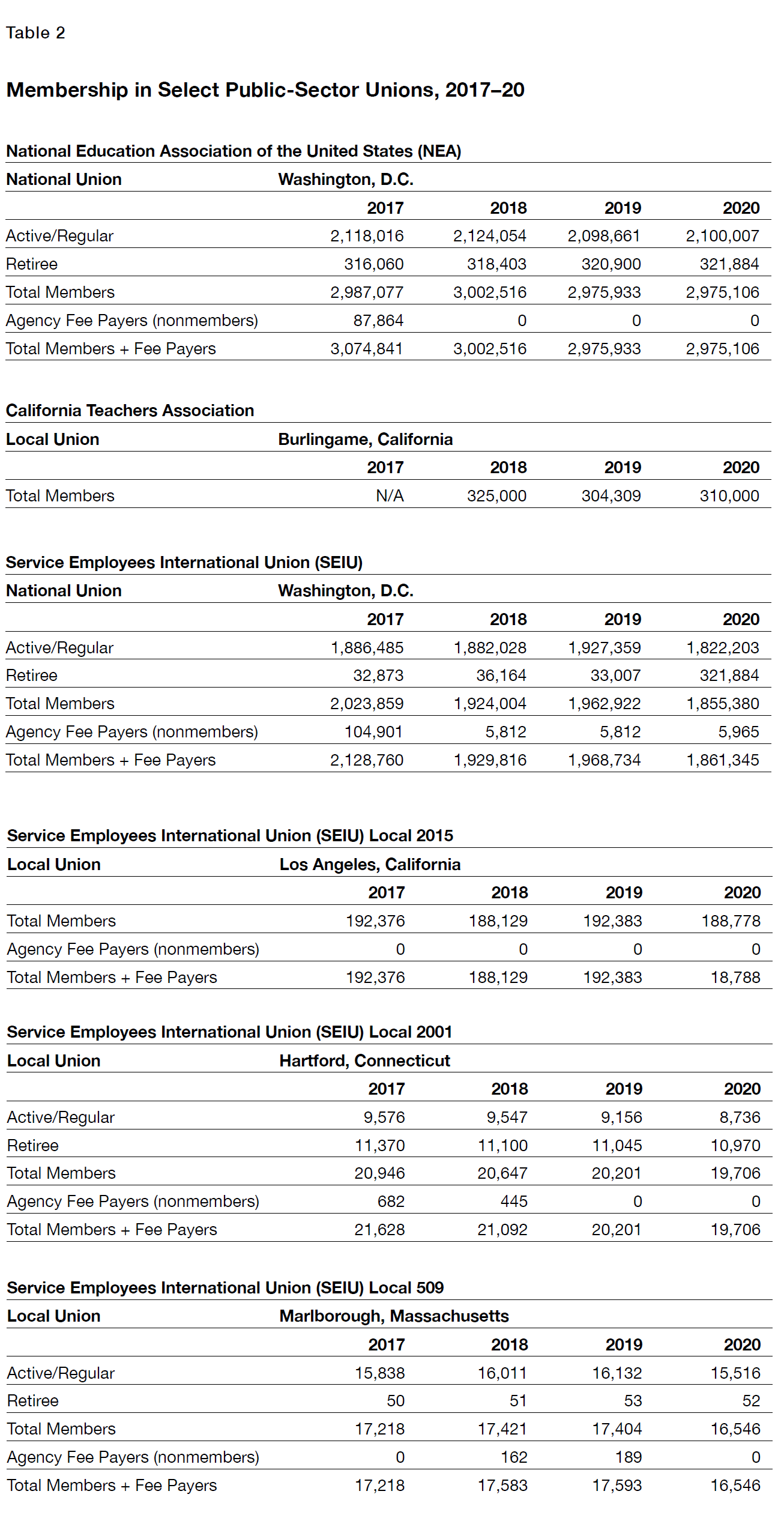

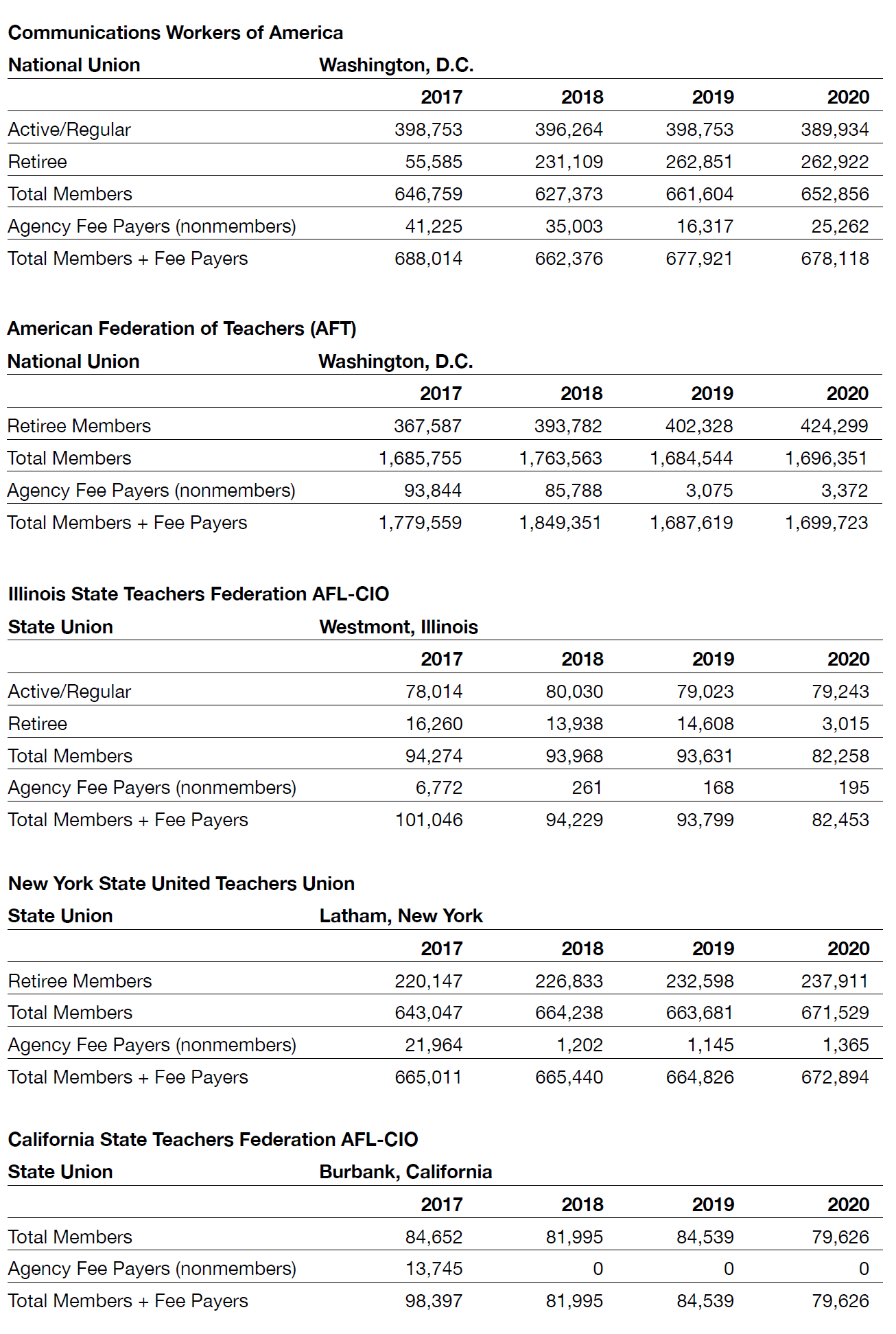
 So, like BLS data, LM-2 reports show relative stability in union membership. Where there were large declines, however, it is unclear how much of this was due to employees voluntarily opting out of unions to avoid agency fees or to reductions in the size of the workforce represented by a particular union. That cannot be determined because OLMS does not require a union to indicate how many employees it represents but only the number who are members. So reports showing declines in teachers union members for 2020–21 may simply reflect a pandemic-induced fall in teacher employment or a larger secular trend of shrinking schools as student populations decline.
So, like BLS data, LM-2 reports show relative stability in union membership. Where there were large declines, however, it is unclear how much of this was due to employees voluntarily opting out of unions to avoid agency fees or to reductions in the size of the workforce represented by a particular union. That cannot be determined because OLMS does not require a union to indicate how many employees it represents but only the number who are members. So reports showing declines in teachers union members for 2020–21 may simply reflect a pandemic-induced fall in teacher employment or a larger secular trend of shrinking schools as student populations decline.
Ohio is the only state to require extensive reporting by public-sector unions that operate within its borders. Yet it is not easy to separate public- and private-sector union members in the Ohio data because private-sector unions can and do represent public-sector workers. Nonetheless, Ohio data do provide a good picture of particular unions that are composed of many, if not all, public employees (Table 3). Consider that the Ohio Education Association (OEH), the statewide teachers’ union affiliate of NEA, had 96,873 full-time educator members in 2017 and 96, 244 in 2020 (the last year for which data are currently available). This suggests, again, a very small drop in union membership. OEH did, however, report losing 1,301 agency fee payers due to the Janus decision. If one can generalize from the experience of OEH, most public-sector unions in Ohio have not seen steep drops in membership.
Government payroll records provide the most accurate data on union membership, which detail the number of workers with union dues being deducted from their wages. However, these records are also the hardest to obtain, usually requiring a Freedom of Information Act (FOIA) petition or another formal public records request. Moreover, these records are not anywhere compiled in a systemic data set for use by analysts and scholars. The best that can typically be done with these data, where available, is to examine a single union or a single jurisdiction. One organization, the Freedom Foundation, makes monthly requests for such union membership data from the Washington State Office of Financial Management and the Oregon Department of Administrative Services for employees of state agencies. Data for local employees or school districts are not yet available.[16]
Contrary to the other data sources, the government employer data from these two states show greater declines in public-union members for specific unions (Table 4). For example, Washington’s AFSCME Council 28, which represents a variety of public employees across the state, saw its dues-paying membership fall from 95.8% of represented employees in June 2018 to 64.7% in November 2021 (the last month for which data are currently available). This was during a period when the state had increased the number of employees represented by the union. In Oregon, SEIU 503, which represented 23,754 state employees in November 2021, had a paying membership of only 62.6%—down from 100% in June 2018, prior to Janus, when agency fees were permissible.
The anomalous decline in union-represented employees in the Washington unions between June 2021 and November 2021 is partly due to seasonal factors (state employment generally increases during the summer months) and partly due to Governor Jay Inslee’s mandatory Covid- 19 vaccination requirement, announced in August and implemented in October, which resulted in many state workers preemptively quitting their jobs, retiring early, or being terminated. It should also be said that the Freedom Foundation has mounted a particularly active and effective campaign to inform workers in Washington and Oregon of their new rights under Janus and to guide them through the process of opting out of the union, if they so desire. Other states typically do not have such an effective organization at work on these issues.
In sum, the best state-level data from Washington, Oregon, and Ohio show steeper declines in union membership than the national data collected by BLS or OLMS. Both national data sources rely on workers or their unions to report information and are thus only as accurate as those reporting. By contrast, the data from Washington and Oregon come from more accurate employer records.
Clearly, union membership is, at best, stable (with marginal increases here and there) or declining. The extent of the decline, as well as where it is happening, is unclear. Nonetheless, it is likely to eventually level off at a fairly high point relative to union membership in states that never permitted government union agency fees.
Money
As with membership, many predicted that public-sector union coffers would take a major hit as a result of the Janus decision. NEA, for example, announced that it would trim its operating budget by more than $50 million in anticipation of a potential 10% membership loss.[17]
Despite the loss of agency fee revenue from nonmembers in 2018, the rough stability of union membership rates, coupled with the margin of maneuver that unions retained to raise dues rates, meant that after an initial period of adjustment, union finances stabilized—and revenues have even increased, in some cases. Although not shown in Table 5 because only a handful of unions specifically report their dues and agency fee revenues, NEA, for example, collected an additional $2.4 million in dues in 2021, bringing its total from that revenue stream to $377.4 million. AFT received almost $11 million more in dues than in 2020, bringing its total to $196.7 million.[18]
Thus, the big story is not the loss of revenues for individual public unions—many of which increased membership slightly, raised dues somewhat, or engineered a combination of both to keep revenues relatively flat.
As far as the fallout from Janus is concerned, the big story is about union federations. Unions in the U.S. are organized as federations, where the national organization sits atop myriad state and local unions. Revenues flow from the bottom up. Local affiliates collect dues and send a portion of them to the state-level union, which, in turn, sends a portion to the national organization. For public-sector unions, the organizational strength of each state affiliate hinges on the favorability of the labor laws in each affiliate’s state. By eliminating agency fees across the country, Janus marked a major change in the revenue environment for local unions within their federations.
Before Janus, public-sector union federations used their large (and stable) revenue streams in strong union states to subsidize affiliates in weaker states. Political scientists Leslie Finger and Michael Hartney found that by eliminating agency fees in all 50 states, Janus will weaken the ability of national union federations to subsidize locals in weak union jurisdictions.[19] That is, revenues drawn from New York and California will be less available to be sent to affiliates in states with a smaller union presence, such as Florida and Texas, if these affiliates face challenges such as hostile legislation, tough strike enforcement, or government layoffs.
Over time, while revenues may remain flat for many unions in strong union states, the ability of the national organizations to redirect monies to unions with lower memberships and less revenue will be diminished. National federations that lose revenues from agency fees cannot as easily raise dues without spurring some members to opt out. So while revenues are currently stable, they are at something of an upper bound. In that respect, the impact of Janus is less likely to show up directly in particular revenue figures but will take place indirectly through the weakened cross-subsidy function of union federations as a whole.
If one looks at total revenues reported by the large union federations on their LM-2 forms, few of them have experienced major declines (Table 5). Instead, some have held relatively stable or slightly increased their total revenue. Their total revenue comes from sources beyond membership dues, although dues constitute the largest source. So it is possible that a union could increase its revenue over the short run, even as it lost dues monies.[20]
The big lesson here is that it appears that public-employee unions have quickly adapted to the loss of agency fees and found ways to keep their revenues stable in the short run. However, the long-run impact of Janus is likely to make it much more difficult for public-sector unions, or union federations with large public-sector memberships, to increase their revenue base.
Conclusion
America’s public-sector unions appear to be settling in to a new equilibrium after a decade or more of major challenges. True, they’ve lost some revenue and some members. But the outcome of Janus has hardly been as catastrophic as many had feared and as others had hoped.
While the membership of public unions may erode a little more over the coming years, barring other policy interventions, it will likely stabilize close to where it is now. However, public unions will soon hit the upper bound of their revenue streams. The national federations will then be less able to cross-subsidize locals in jurisdictions with fewer members.
Still, given the weaknesses in the data sources available, we cannot be certain exactly what has happened to public-union membership post-Janus. A small step toward rectifying this situation would be to improve the federal reporting requirements of all public-sector unions. Only if the federal government can collect and publish more accurate data can workers across the country see into the organizations to which they belong and pay dues. Greater transparency would also furnish public employers with a window into the organizations with which they must negotiate. Finally, the public could have access to more accurate data on powerful interest groups, whose existence and power are largely derivative of state laws.
About the Author
Daniel DiSalvo is a senior fellow at the Manhattan Institute and a professor of political science in the Colin Powell School at the City College of New York–CUNY. DiSalvo’s scholarship focuses on American political parties, elections, labor unions, state government, and public policy. He is the author of Engines of Change: Party Factions in American Politics, 1868–2010 (2012) and Government Against Itself: Public Union Power and Its Consequences (2014). DiSalvo writes frequently for scholarly and popular publications, including National Affairs, City Journal, American Interest, Commentary, Los Angeles Times, New York Daily News, and New York Post. He is coeditor of The Forum: A Journal of Applied Research in Contemporary Politics. DiSalvo holds a Ph D in politics from the University of Virginia.
Endnotes
Are you interested in supporting the Manhattan Institute’s public-interest research and journalism? As a 501(c)(3) nonprofit, donations in support of MI and its scholars’ work are fully tax-deductible as provided by law (EIN #13-2912529).
